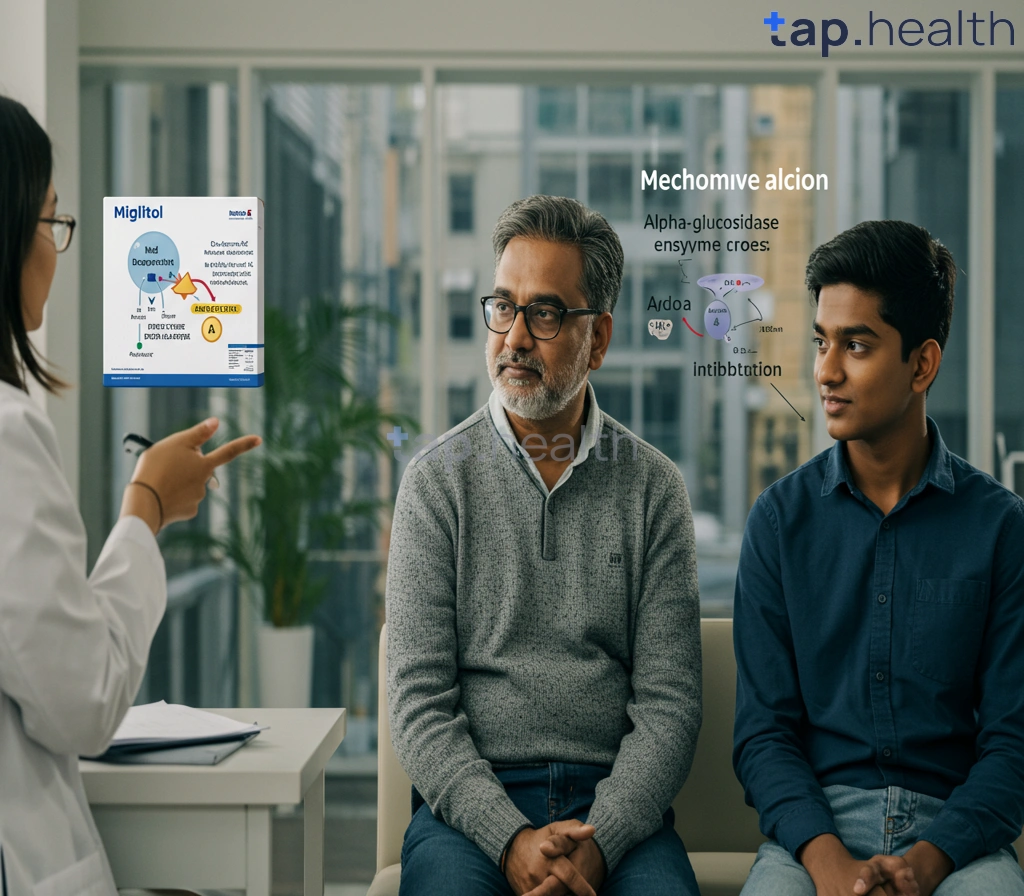Table of Contents
- Miglitol (Oral): A Comprehensive Guide to Alpha-Glucosidase Inhibition
- Understanding Miglitol: How This Drug Lowers Blood Sugar
- Miglitol vs. Other Diabetes Medications: Key Differences and Similarities
- Is Miglitol Right for You? Evaluating Benefits and Potential Side Effects
- Managing Type 2 Diabetes: The Role of Miglitol and Lifestyle Changes
- Frequently Asked Questions
- References
Managing type 2 diabetes can feel like navigating a complex maze, but understanding your medications is a crucial first step. This blog post focuses on Miglitol (Oral Route): Understanding This Alpha-Glucosidase Inhibitor, a medication that works differently than many other diabetes drugs. We’ll explore how Miglitol helps control blood sugar levels, delve into its mechanism of action, and discuss important considerations for those prescribed this treatment. Ready to unravel the mysteries of Miglitol and its role in diabetes management? Let’s get started!
Miglitol (Oral): A Comprehensive Guide to Alpha-Glucosidase Inhibition
Understanding Miglitol’s Role in Managing Type 2 Diabetes
Over 80% of individuals with Type 2 diabetes in India and other tropical countries grapple with insulin resistance, a critical factor influencing blood sugar control. Miglitol, an oral alpha-glucosidase inhibitor, offers a targeted approach to managing this prevalent condition. It works by slowing down the breakdown of carbohydrates in the digestive system, leading to a more gradual rise in blood glucose levels after meals. This makes it particularly beneficial for individuals experiencing postprandial hyperglycemia—a spike in blood sugar after eating.
How Miglitol Differs from Other Diabetes Medications
Unlike insulin or other medications that affect insulin production or sensitivity, Miglitol directly impacts carbohydrate digestion. This makes it a valuable tool, often used in conjunction with other treatments, especially in cases of insulin resistance prevalent in many Indian and tropical populations. Its mechanism of action makes it a useful adjunct for better blood glucose management, particularly after high-carbohydrate meals common in many regional diets. Remember to always consult your doctor before starting or changing any diabetes medication.
Practical Tips for Effective Miglitol Use
Proper dosage and timing are crucial. Your doctor will determine the appropriate dose based on your individual needs and overall health. Consistency is key. Taking Miglitol with every meal containing carbohydrates is essential to maximize its effect. Additionally, maintaining a balanced diet with controlled carbohydrate intake remains paramount for optimal glucose control. Regular monitoring of blood sugar levels is vital to track the effectiveness of Miglitol and make any necessary adjustments. For more information on managing blood sugar, you might find our article on 10 Ways to Decrease Triglycerides helpful, as triglycerides are often linked to blood sugar control.
Seeking Expert Advice in India and Tropical Regions
For individuals in India and other tropical regions, access to qualified healthcare professionals is vital for personalized diabetes management. Regular check-ups, blood sugar monitoring, and discussions with your doctor will ensure you are receiving the best care tailored to your unique needs and regional dietary considerations. Don’t hesitate to discuss any concerns or questions you have about Miglitol with your healthcare provider. If you’re considering other supplements for diabetes management, it’s important to research thoroughly. You may find our article on Is Glucocil Safe for Type 2 Diabetes? informative.
Understanding Miglitol: How This Drug Lowers Blood Sugar
Maintaining healthy blood sugar levels is crucial, especially in India and other tropical countries where diabetes is prevalent. Understanding how medications like Miglitol work is key to effective management. Miglitol is an alpha-glucosidase inhibitor, meaning it works by slowing down the breakdown of carbohydrates in your digestive system. This results in a slower and more gradual rise in blood glucose levels after meals. This is particularly beneficial for individuals with type 2 diabetes or those at risk of developing the condition, especially considering that a fasting blood sugar level of 140–199 mg/dL indicates prediabetes, while 200 mg/dL or higher suggests diabetes. For more information on maintaining healthy blood sugar levels, check out our comprehensive guide.
How Miglitol Differs from Other Diabetes Medications
Unlike insulin or other medications that work by increasing insulin sensitivity or production, Miglitol directly impacts carbohydrate digestion. This means it helps prevent blood sugar spikes often seen after consuming carbohydrate-rich meals common in many Indian and tropical diets. It’s important to note that Miglitol is usually used in conjunction with other diabetes medications or lifestyle changes, such as diet and exercise. Remember, Miglitol does not replace the importance of maintaining a healthy lifestyle.
Practical Considerations for Miglitol Use in Tropical Climates
In hotter climates, dehydration can affect blood sugar control. Therefore, proper hydration is essential while taking Miglitol. Furthermore, consult your doctor about potential interactions with other medications, particularly those you might be using for common tropical illnesses. Regular monitoring of your blood sugar levels, along with adherence to your doctor’s prescribed dosage, are vital for effective management. Consult your physician or a qualified healthcare professional to determine if Miglitol is the right treatment option for you. They can help you understand the potential benefits and risks of this medication within the context of your individual health needs and lifestyle. Understanding the connection between weight loss and blood sugar levels can also be beneficial in managing your diabetes.
Miglitol vs. Other Diabetes Medications: Key Differences and Similarities
Miglitol, an alpha-glucosidase inhibitor, stands apart from other diabetes medications in its mechanism of action. Unlike insulin or metformin, which primarily affect insulin production or sensitivity, miglitol works by slowing down the breakdown of carbohydrates in the gut. This leads to a more gradual rise in blood glucose levels after meals, reducing postprandial hyperglycemia. This is particularly relevant in managing blood sugar spikes common after consuming carbohydrate-rich meals prevalent in many Indian and tropical diets. Remember, the recommended carbohydrate intake per meal for most people with diabetes is around 45–60 grams, a figure that should be personalized based on individual needs and dietary habits.
Key Differences:
Miglitol’s unique mechanism distinguishes it from other anti-diabetic drugs. Insulin and sulfonylureas stimulate insulin secretion, while metformin improves insulin sensitivity. Thiazolidinediones (TZDs) also enhance insulin sensitivity. However, Miglitol directly impacts carbohydrate digestion, making it a valuable addition to a treatment plan, especially for individuals experiencing significant post-meal glucose spikes. It’s often used in combination with other medications for better blood sugar control. Choosing the right medication is crucial, and you might find our article on Which Diabetes Drug is Best for Diabetics with Kidney Disease? helpful in understanding other options.
Similarities:
All these medications share the common goal of managing blood glucose levels and preventing complications of diabetes. They all require careful monitoring of blood glucose levels and regular medical check-ups. Furthermore, maintaining a healthy lifestyle, including regular exercise and a balanced diet (considering the 45–60 gram carbohydrate guideline per meal), remains crucial regardless of the specific medication used. Remember to consult your doctor about any dietary supplements you might be considering; our blog on Safe and Effective Dietary Supplements for Diabetes Care offers valuable insights.
Regional Considerations:
In many Indian and tropical countries, diets often feature high carbohydrate content from rice, grains, and fruits. This makes understanding postprandial glucose control crucial. Miglitol’s ability to manage post-meal glucose spikes could be particularly beneficial in these regions, helping to mitigate the risk of diabetes complications. Always consult your doctor to determine if Miglitol is the right treatment for you, considering your individual dietary habits and health status. Regular monitoring and adherence to your prescribed treatment plan are vital for effective diabetes management.
Is Miglitol Right for You? Evaluating Benefits and Potential Side Effects
Maintaining healthy blood sugar levels is crucial, especially in regions like India and other tropical countries where diabetes prevalence is high. Ideal blood sugar control involves keeping pre-meal levels between 80–130 mg/dL and post-meal levels below 180 mg/dL. Miglitol, an alpha-glucosidase inhibitor, can play a role in achieving these targets for some individuals. It works by slowing down the absorption of carbohydrates, thus preventing rapid spikes in blood sugar after meals. This is particularly beneficial for those with type 2 diabetes who struggle to manage postprandial hyperglycemia.
Benefits of Miglitol
Miglitol offers several advantages. By reducing post-meal glucose surges, it can help improve long-term glycemic control and potentially reduce the risk of diabetes complications common in tropical climates, such as diabetic neuropathy and retinopathy. Furthermore, some studies suggest it might contribute to modest weight loss, a significant factor in managing diabetes, particularly prevalent in certain Indian populations. However, it’s crucial to remember that Miglitol is not a standalone solution and should be used in conjunction with lifestyle modifications like diet and exercise. A healthy diet, including foods like those discussed in Amazing Health Benefits of Millets: Tap Health, can significantly support blood sugar management.
Potential Side Effects and Considerations
While generally well-tolerated, Miglitol can cause gastrointestinal side effects such as bloating, gas, and diarrhea. These are more common initially and often lessen as the body adjusts. For individuals in India and other tropical countries with pre-existing digestive issues, these side effects could be more pronounced. It’s crucial to discuss these potential side effects with your doctor before starting Miglitol. Furthermore, careful monitoring of blood sugar levels is essential to determine its effectiveness and adjust dosages accordingly. Interactions with other medications are also possible. It’s important to remember that managing diabetes often involves considering various supplements and medications; understanding the potential interactions is vital. For example, you might want to consider the information in our article, Can a Diabetic Take Shilajit?
Making an Informed Decision
Ultimately, the suitability of Miglitol depends on individual health conditions and lifestyle. Consult your physician or a certified diabetes educator to discuss whether Miglitol is the right choice for you, considering your specific needs and the prevalence of diabetes-related complications in your region. They can help you weigh the benefits against the potential side effects and develop a comprehensive diabetes management plan tailored to your circumstances. Remember, proactive management and regular check-ups are key to maintaining healthy blood sugar levels.
Managing Type 2 Diabetes: The Role of Miglitol and Lifestyle Changes
Understanding Miglitol’s Role in Diabetes Management
Type 2 diabetes is a significant health concern, particularly in India and other tropical countries. However, it’s crucial to remember that up to 80% of Type 2 diabetes cases can be delayed or prevented through lifestyle modifications. Miglitol, an alpha-glucosidase inhibitor, plays a supporting role in this management strategy. It works by slowing down the breakdown of carbohydrates in the gut, leading to a more gradual rise in blood sugar levels after meals. This can be beneficial for individuals already making lifestyle changes. Remember, Miglitol is a medication and should only be used under the guidance of a healthcare professional.
Lifestyle Changes: Key to Preventing and Managing Type 2 Diabetes
Integrating lifestyle changes is paramount. This includes adopting a balanced diet rich in fruits, vegetables, and whole grains, while limiting processed foods, sugary drinks, and saturated fats. Regular physical activity is equally vital. Aim for at least 150 minutes of moderate-intensity aerobic exercise or 75 minutes of vigorous-intensity exercise per week, broken into manageable sessions. Weight management is also crucial, as even modest weight loss can significantly improve blood sugar control. For individuals in India and tropical regions, incorporating traditional, locally-sourced, whole foods into a balanced diet can provide additional nutritional benefits and support overall well-being. For more simple yet effective changes, check out 5 Easy Lifestyle Changes to Manage Type 2 Diabetes.
Seeking Expert Advice
Making informed choices is essential for effective diabetes management. Consult with your doctor or a qualified healthcare professional to discuss whether Miglitol is appropriate for your individual needs and to develop a comprehensive diabetes management plan that includes both medication and crucial lifestyle adjustments. This proactive approach, combined with consistent effort, can significantly improve your health outcomes and quality of life. The challenges of managing diabetes can evolve over time, so it’s beneficial to consider the information in Managing Diabetes as You Age: Challenges and Solutions.
Frequently Asked Questions on Miglitol (Oral Route)
Q1. What is Miglitol and how does it work?
Miglitol is an oral medication used to treat type 2 diabetes. Unlike insulin or metformin, it works by slowing down the breakdown of carbohydrates in your digestive system, leading to a more gradual rise in blood sugar after meals.
Q2. What are the benefits of using Miglitol?
Miglitol is particularly helpful in managing high blood sugar after meals (postprandial hyperglycemia). It’s often used in conjunction with other diabetes treatments and lifestyle changes to better control blood sugar levels.
Q3. What are the potential side effects of Miglitol?
The most common side effects of Miglitol are gastrointestinal issues. It’s important to discuss any concerns with your doctor.
Q4. How should I take Miglitol, and what precautions should I take?
Miglitol should be taken with meals containing carbohydrates. Consistent dosage is important. Regular blood sugar monitoring and a balanced diet are essential for effective management. It’s crucial to consult your doctor about potential drug interactions, especially in tropical climates.
Q5. Is Miglitol right for me?
Whether Miglitol is suitable for you depends on your individual health situation and other medications you may be taking. It’s vital to consult your healthcare professional to determine if it’s the right treatment for you and to discuss potential interactions and precautions.
References
- A Practical Guide to Integrated Type 2 Diabetes Care: https://www.hse.ie/eng/services/list/2/primarycare/east-coast-diabetes-service/management-of-type-2-diabetes/diabetes-and-pregnancy/icgp-guide-to-integrated-type-2.pdf
- Diabetes Mellitus: Understanding the Disease, Its Diagnosis, and Management Strategies in Present Scenario: https://www.ajol.info/index.php/ajbr/article/view/283152/266731



